In 2008, financial crisis "prophet" Raoul Pal discusses wealth accumulation and macro trend insights in cryptocurrency.
Compiled by: KarenZ, Foresight News
Raoul Pal, a former Goldman Sachs executive, author of "Global Macro Investor," and founder of Real Vision, is renowned for successfully predicting the 2008 financial crisis. Recently, in a conversation with "When Shift Happens" and during a speech at the Dubai Sui Basecamp, Raoul Pal delved into how to steadily accumulate wealth in the cryptocurrency space and explored topics such as Bitcoin, Ethereum, Meme coins, AI, NFTs, the Sui ecosystem, Bitcoin strategies, investment strategies, macro trends, and market directions.
Highlights from Raoul Pal's conversation with When Shift Happens
1. How to Get Rich in Crypto Without Luck?
How to get rich in Crypto without relying on luck? Simply buy Bitcoin and adopt a DCA (Dollar-Cost Averaging) strategy.
Beginners often fall into the trap of seeking quick riches, a mindset fraught with danger.
When you start envying others for achieving 100x returns, you have already entered a perilous zone. Losing rationality and succumbing to greed can easily ruin your investments.
The Crypto space is filled with numerous risks, such as DeFi attacks and wallet thefts, which require investors to remain vigilant and adhere to rationality.
2. On Meme Coins
Regarding Meme coins, Raoul Pal stated that he does not hold Fartcoin but does hold SCF (Smoking Chicken Fish) and DODE. Although SCF has dropped 90%, it is currently showing a good rebound trend. He specifically cautioned investors not to let Meme coins like Fartcoin, WIF, or BONK occupy too large a proportion of their portfolios, as these coins have an 85% chance of going to zero. He was even surprised that LUNA did not evolve into a Meme coin, as he initially thought people would go crazy buying it.
3. Stay Away from Market Panic, Return to Value Investing
If investors feel panic about the market, Pal suggests they should calmly return to life and stay away from trading screens. Those 5-minute and 1-hour candlestick charts do not provide substantial help for investment decisions.
Many people fantasize about becoming successful traders and earning 100x returns, but the reality is that true wealth accumulation in this field comes from those who consistently buy and hold for the long term.
4. Beware of Crypto Yield Risks
Regarding Crypto Yield, such as earning returns through staking, there are also risks involved. For ordinary investors, when faced with an opportunity that seems to offer a 20% return, it is crucial to be aware of the risks involved.
5. How to View Michael Saylor's Bitcoin Buying Strategy?
The Bitcoin strategy of Strategy is creating leverage within the system. Strategy purchases Bitcoin by issuing convertible bonds, which essentially involves selling options at a lower cost. These options are bought by arbitrageurs (options traders), who then hedge on exchanges to manage Bitcoin price fluctuations and the risks associated with MicroStrategy stock options.
At the same time, arbitrageurs will exploit the fluctuations between MicroStrategy's NAV and Bitcoin prices, as well as engage in trading using market tools like perpetual contracts and spot-futures spreads.
Currently, the buyers of Strategy's convertible bonds are mostly TradFi hedge funds and other institutions. Sovereign wealth funds like Norway's may only focus on the Bitcoin element, while large hedge funds like Citadel, Millennium, and Point72 are also engaging in arbitrage. These institutions are experienced in risk management and may receive systemic support, with reasonable position size control, making them less prone to liquidation.
In stark contrast, traders who excessively use high leverage face enormous risks, and cases of trading failures due to over-leverage are common in the market.
6. Raoul Pal's Capital Allocation
Regarding capital allocation, Raoul Pal stated that Sui accounts for 70%, now far exceeding Solana. The adoption and developer activity of Sui are performing well. Additionally, he holds some DEEP (DeepBook), which is a liquidity layer protocol within the Sui ecosystem.
7. The Value and Potential of NFTs
As an innovative technology that can permanently store and trade non-transferable assets, Pal is optimistic about the future of NFTs. From a macro perspective, the current Crypto industry is valued at $3 trillion, and if it grows to $100 trillion in the next 10 years, it will create a massive wealth of $97 trillion; even a conservative estimate of $50 trillion would still generate a wealth increment of $47 trillion.
This wealth will flow to different people. Art is upstream of everything, and digital art, as an emerging field, is expected to become a significant destination for wealth. In the digital art space, we have XCOPY and Beeple, which have given rise to the generative art movement. I have spent a lot of time talking to some very famous people who are very interested in this field. After crypto OGs have made enough money, their desire to collect art is extremely strong. For example, CryptoPunk symbolizes your identity and allows you to meet like-minded people. From institutions to super-rich individuals, ordinary people are gradually beginning to realize the importance of digital art. We are still in the early stages. I own many artworks, and I believe this spans over a decade.
8. The Advantages and Prospects of Ethereum
Regarding Ethereum, its network capacity has surpassed current system demands, and adjustments may be made to some mechanisms in the future, returning to Layer 1. The status of EVM is akin to Microsoft; many banks, insurance companies, and large enterprises around the world rely on Microsoft rather than Apple or Google.
Once you have a corporate sales model, it is almost impossible to remove it from the company because you do not want to change it or take risks. From the Lindy effect (the longer something has existed, the greater the likelihood it will continue to exist), Ethereum has stood the test of time and can meet the demands of the financial market well. Will Goldman Sachs or JPMorgan build on Solana? Unlikely. Ethereum may bring a new narrative to the market and is expected to outperform Bitcoin in the short term. Looking ahead five years, unless they mess everything up, its importance will only become more pronounced.
The concepts of Bitcoin's Lightning Network, payments, etc., have limited effects on price increases; the core value of Bitcoin lies in its role as a store of value; the same will happen with ETH.
9. On AI
The development of AI is rapid, and its performance has surpassed 99% of analysts. After deep reflection, Pal believes that the rise of AI raises profound questions about consciousness and the future role of humanity. He suggests that people actively engage with, deeply understand, and skillfully utilize AI technology.
Secondly, we do not know what this means for employment and how we create wealth, but I know what humans excel at. What can humans do that AI cannot? That is to be human.
I developed an AI Raoul that can read the news daily, which is also written by AI, and I built a chatbot trained on my own voice, with training data covering all my X content, YouTube content, and 100 books. Now, Real Vision users can interact with this chatbot. Pal predicts that soon these two technologies will merge, and this transformation will have a profound impact on the podcast and media industries, with the media content everyone encounters becoming uniquely personalized. Moreover, human memories and actions may ultimately become "nourishment" for AI, achieving a form of "immortality."
10. Market Attention and Quality Project Selection
This is a game of attention. People's focus on key tokens is scattered, and the duration of many narratives is relatively short. Pal emphasizes that holding Bitcoin is always a wise choice; additionally, buying Solana at the bottom of the cycle and purchasing SUI last year are also good strategies.
Investors should focus their attention on the top 10 or top 20 tokens, particularly those projects that can continuously enhance network adoption, as these projects often have higher investment value. According to Metcalfe's Law, project potential can be assessed based on active user numbers, total transaction value, and user value.
The Bitcoin network has a large number of users, and sovereign nations are participating in purchases, which is why Bitcoin is more valuable; Ethereum has a vast user base and rich applications, and although the emergence of L2 complicates the situation slightly, it still possesses significant value. Investors should actively seek projects that see growth in both user numbers and application value, such as Solana, which saw its developer community grow steadily at the bottom of the cycle, maintaining stable user numbers, and the emergence of Bonk further boosted market confidence in Solana (Note: The host mentioned that in a previous conversation with toly, toly pointed out that Mad Lads was a turning point for Solana); Sui is similar.
Raoul Pal's speech highlights at the Dubai Sui Basecamp
1. Core Macro Factors: Liquidity and currency depreciation. Cryptocurrency and the economy exhibit a four-year cycle, driven by the debt refinancing cycle. Since the global debt peaked in 2008, we have maintained economic operations through borrowing new to pay old.
2. Aging Population and Economic Growth: The aging population is causing economic growth to slow down, requiring more debt support to maintain GDP growth. This phenomenon is widespread in many parts of the world, and the correlation between debt and GDP can clearly illustrate this dynamic.
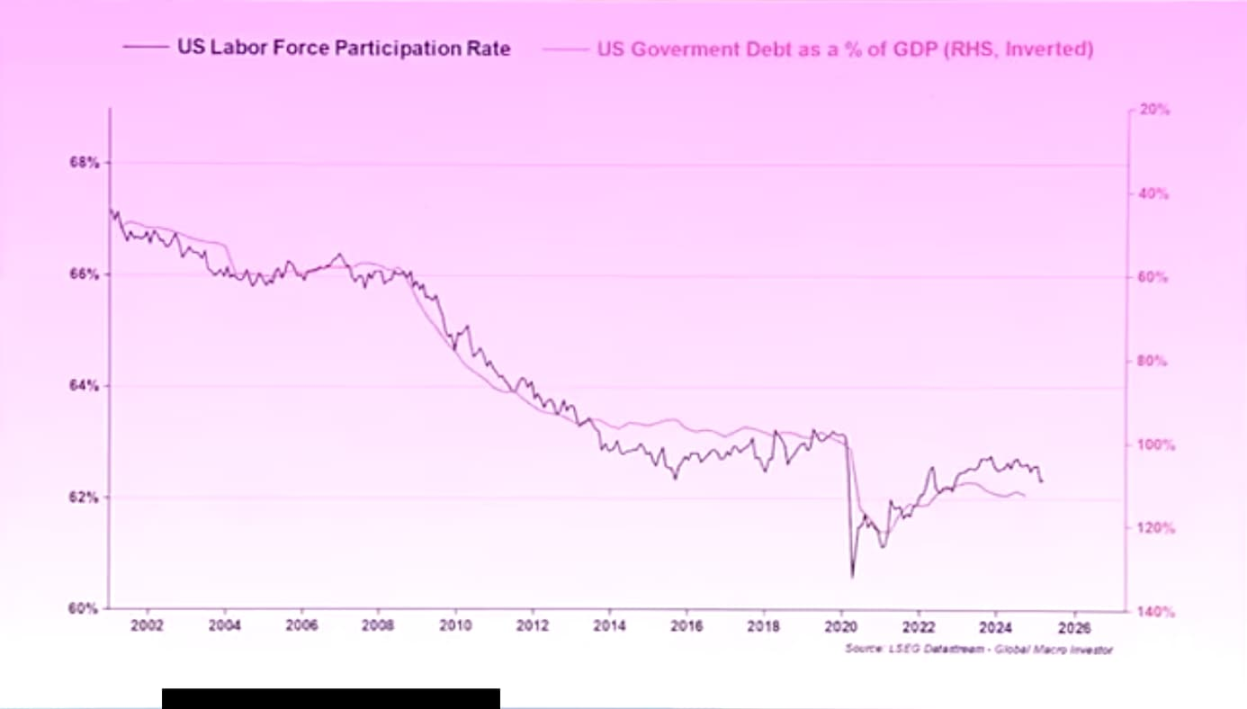
3. Liquidity Drives Everything: The Federal Reserve's net liquidity is a core indicator. From 2009 to 2014, liquidity was primarily provided through balance sheet expansion, followed by the introduction of tools like bank reserve adjustments. Currently, total liquidity (including M2) is crucial, and it has an astonishing explanatory power regarding the trends of Bitcoin (90% correlation) and Nasdaq (97% correlation).
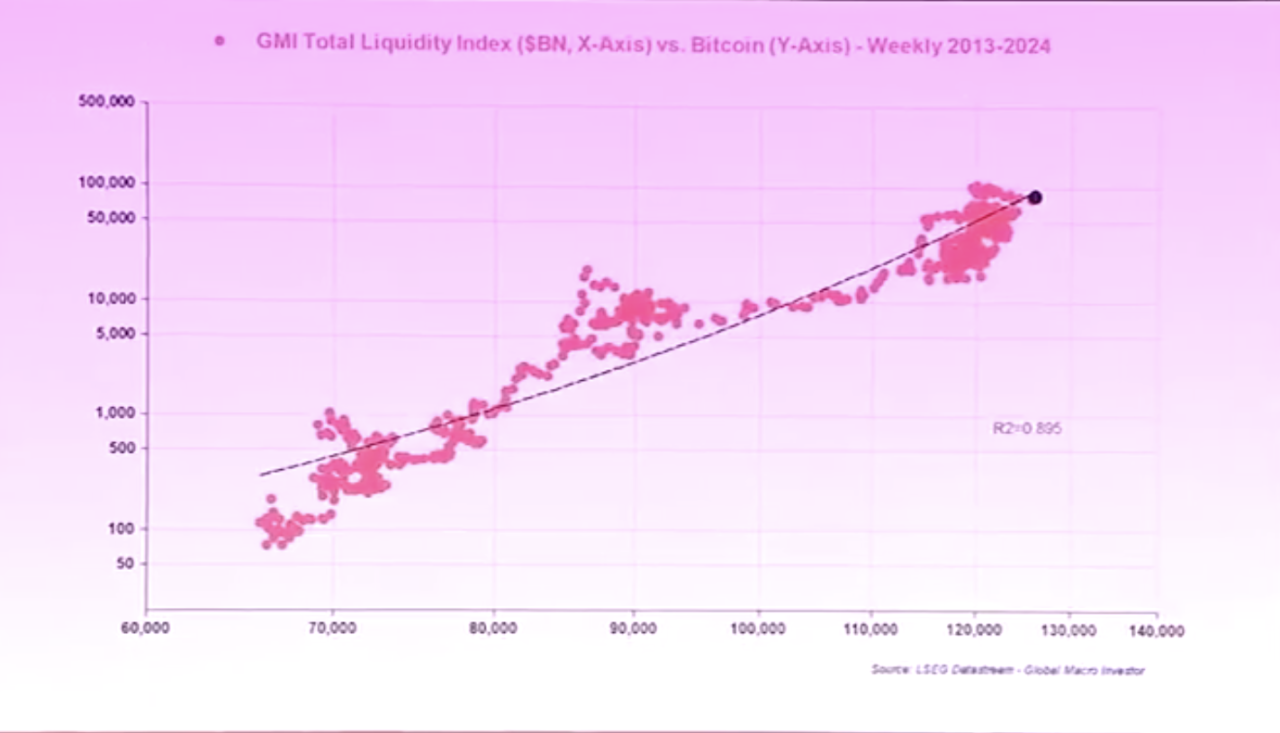
4. Currency Depreciation Mechanism: Currency depreciation is akin to a global tax, with an implicit inflation tax of 8% annually, plus 3% explicit inflation, meaning you need an annual return of 11% to maintain your wealth. This explains why young people are flocking to the crypto space—traditional assets (real estate, stocks, etc.) are underperforming, forcing them to seek excess returns through high-risk assets.
5. Wealth Disparity and Crypto Opportunities: The rich hold scarce assets, while the poor rely on labor income (which is declining in purchasing power year by year). The crypto system disrupts this pattern—young people are seeking breakthroughs through high-risk assets.
6. Performance of Crypto Assets: Since 2012, the annualized return has been 130% (including three major corrections), with Ethereum at 113% and Solana at 142%. Bitcoin has seen a cumulative increase of 2.75 million times, which is extremely rare in the investment field, and crypto assets are gradually becoming a "super black hole" for attracting funds.
7. Huge Potential of the Sui Ecosystem: DEEP (DeepBook liquidity layer protocol) has recently performed the best. The SOL/SUI ratio indicates that SUI is relatively strong.
8. Analysis of Current Market Misjudgments: People often interpret the current market narrative (such as tariff panic) using liquidity conditions from three months ago, but this is misleading. In reality, the tightening of financial conditions in Q4 2024 (rising dollar interest rates and oil prices) has a three-month lag effect. The economic surprise index (comparing the U.S. and globally) indicates that the current economic weakness is only a temporary phenomenon. Looking back at the 2017 Trump tariff cycle, the dollar rose and then fell, followed by liquidity driving asset prices significantly higher.
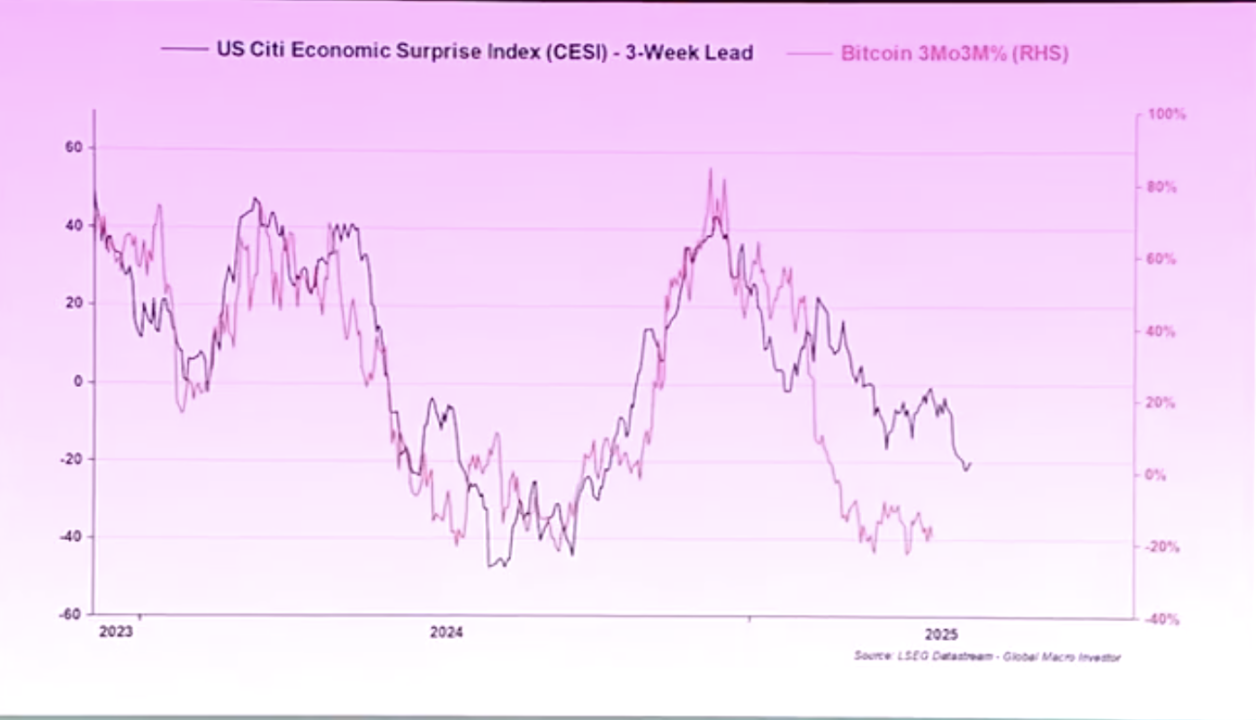
9. Global M2 and Asset Relationship: When global M2 hits a new high, asset prices should rise in tandem. Taking Bitcoin as an example, its price trend typically shows a breakout, a retest, and then accelerates in the "banana zone." Compared to the 2017 cycle, Bitcoin's increase that year was 23 times; although the current market is different, a considerable increase is still expected. The current market is in the correction phase after breaking through the first part of the "banana zone," and is about to enter the second part, which usually heralds an altcoin rally.
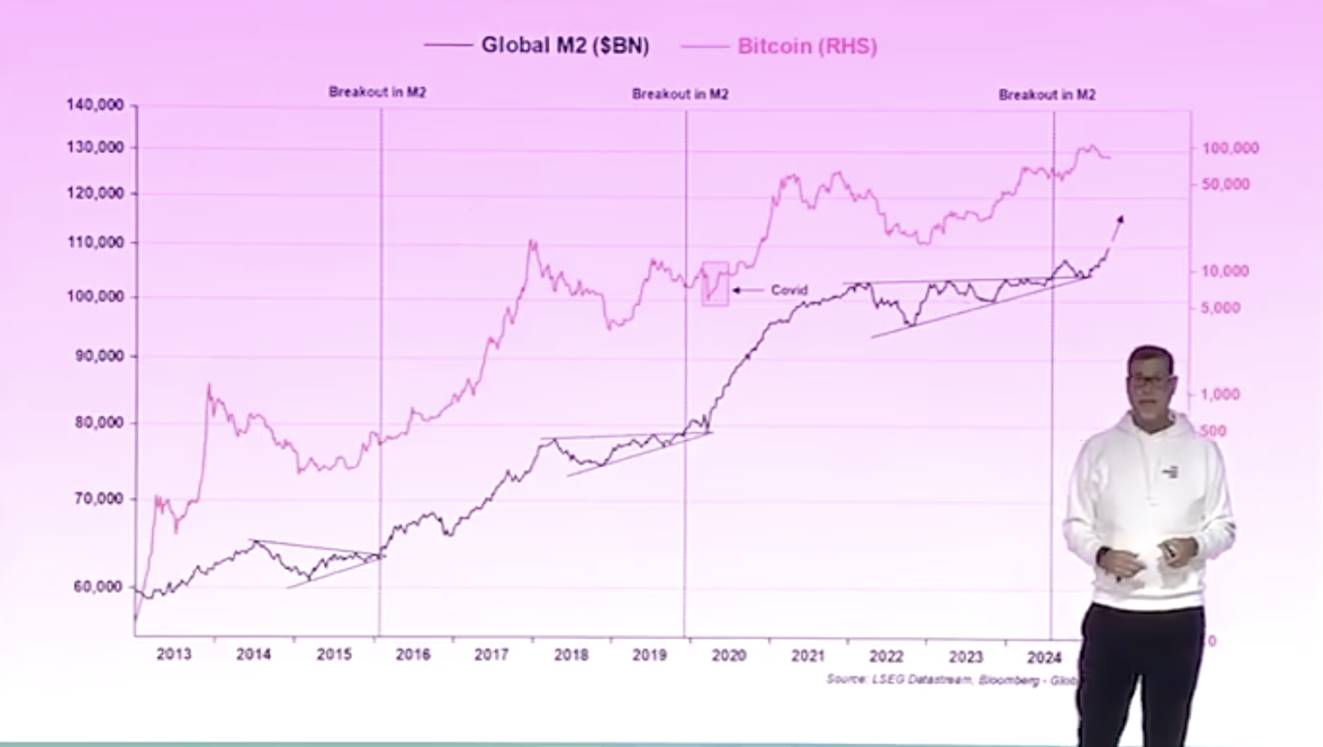
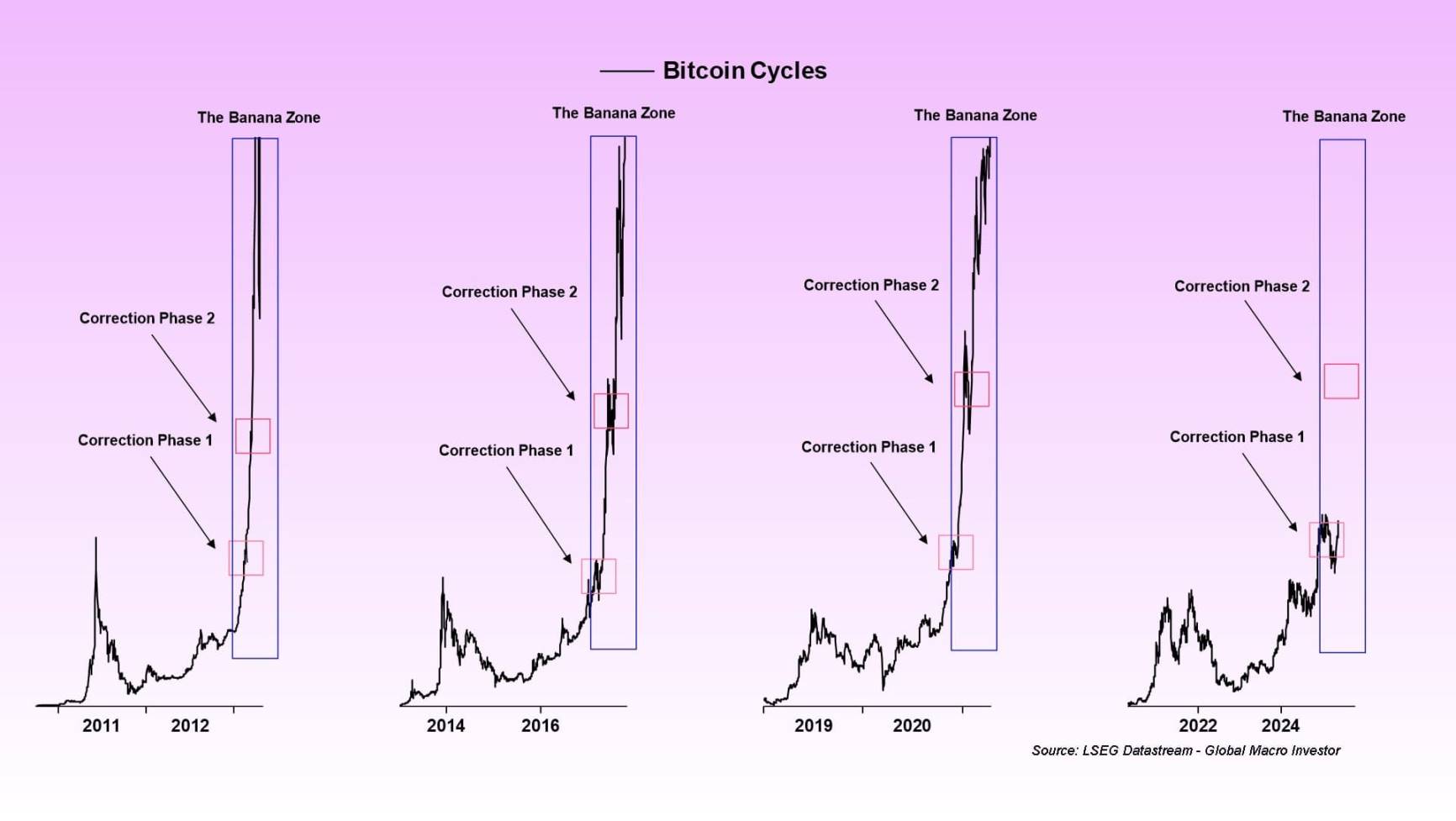
10. Business Cycle and Bitcoin Trends: The ISM Manufacturing Index is an important leading indicator. When this index breaks above 50, it signals a return to economic growth, increased corporate earnings, and active reinvestment of funds, leading to an acceleration in Bitcoin prices. If the ISM index reaches 57, Bitcoin prices could even hit $450,000. As the business cycle warms up and household cash increases, risk appetite rises, making the investment logic for altcoins similar to that of junk bonds and small-cap stocks.
Note: Raoul Pal is also a board member of the Sui Foundation.
免责声明:本文章仅代表作者个人观点,不代表本平台的立场和观点。本文章仅供信息分享,不构成对任何人的任何投资建议。用户与作者之间的任何争议,与本平台无关。如网页中刊载的文章或图片涉及侵权,请提供相关的权利证明和身份证明发送邮件到support@aicoin.com,本平台相关工作人员将会进行核查。




